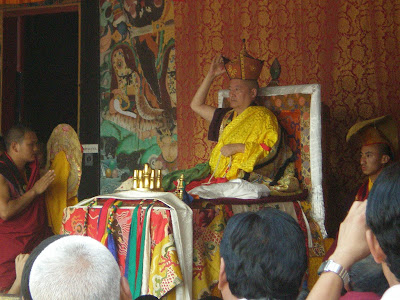The final event of the week was a long life empowerment. This was given by the powerful Rinpoche who acts as the Karmapa's regent at Rumtek, who came to oversee the end of the puja / the dance (see last post). A lot of lay people showed up, even more than for the lama dance the previous day, which surprised me. It did not, however, surprise the monks, who pointed out to me how much more valuable a long life is, in the eyes of most people, than a day watching dancing.
The day was hot (well, for Rumtek anyway. Mid 80s probably...), and so people brought umbrellas to stay shaded. I've noticed that the people at Rumtek seem to have a very Seattleite temperature sensitivity, with a range of about 15* of acceptable temperatures (they do not, however, have the Seattleite drive to be outside in any available sun).
(laypeople and monks, sheltering under umbrellas)
One especially important part of the ceremony involved one of the valuable relics housed at Rumtek, a very powerful crown. It is not as powerful, I was told, as the black crown (the crown of the Karmapas), but it is still quite powerful. During the crown section of the ceremony, the Rinpoche held the crown (as you see below) while monks chanted and played instruments.
(the crown)
Following this, the Rinpoche put on a different hat, of a style worn by all of the rinpoches (at least in the Karma Kagyu sect), and led a long prayer with more chanting and instrument playing by the monks.
(I love this angle because you can see some of the amazing paintings on the outside of the prayer hall)
And then, following the prayers, were the individual empowerments. Probably over a thousand people lined up to be empowered. Each person gave an offering of a white scarf (see yesterday's post for an explanation of these), and was then ushered on through by the line of monks managing the affair (in order to keep things moving, the monks had to have a bit of a firm hand).
The Rinpoche touched each person on the head with a metal chalice, and both the young boy you can see to the right of the Rinpoche (a tulku, a reincarnated lama, and so a Rinpoche himself) and the man to the right of him (Khenpo Kalsang Nyima, principal of the Institue) touched each person's head with what I believe were images of deities.
After everyone who wished to had been empowered, the lay people went home. The monks had one last puja in the main prayer hall, and the weeklong intensive was over. Although all of the monks I spoke to were glad of the opportunity to take part in the puja (which makes sense, because they are, after all, monks), it also seemed to be a bit of a relief that the week was over. There had been few moments to relax for the whole week, and so the monks took full advantage the rest of the day
(finally time to read and use cellphones!)
(and make silly faces!)
(and relax on the grass!)
Following the empowerment ceremony, I was told that the empowerment was connected with the Avalokiteshvara (the bodhisattva of compassion) mantra om mani padme hung. Aside from being one of the most popular mantras in Tibetan Buddhism, this is also the mantra on the prayer wheels at the monastery.
(prayer wheels, looking especially beautiful in the gorgeous weather which followed the empowerment)
Although anyone can recite this mantra, I was told that (because I had been empowered by the Rimpoche) I had now been empowered in its use. Empowerment in the use of matras is tantric practice that I do not really understand (because tantra is complex and largely secret), but I know it's a good thing.
After 5 days of daily posts, expect the next update with a little more delay. But it will happen soon, and it will be good. So remember to come back and check it out. Also, comments are always welcome. So if you are enjoying the posts, consider it (and a big thank you to those who have already done so!).



















































